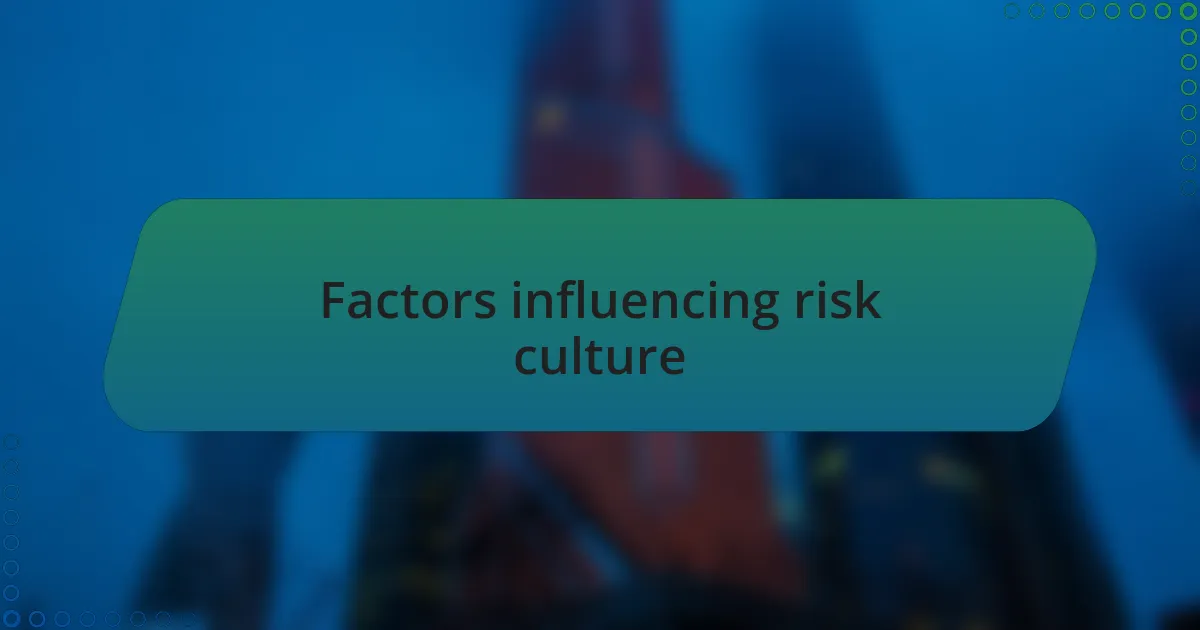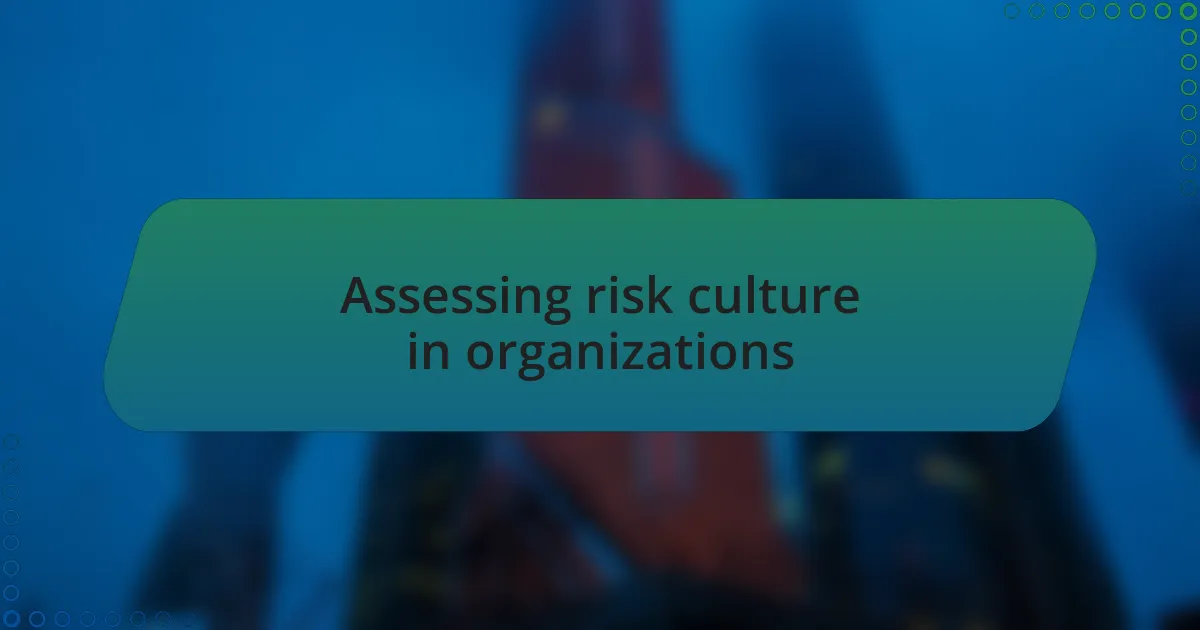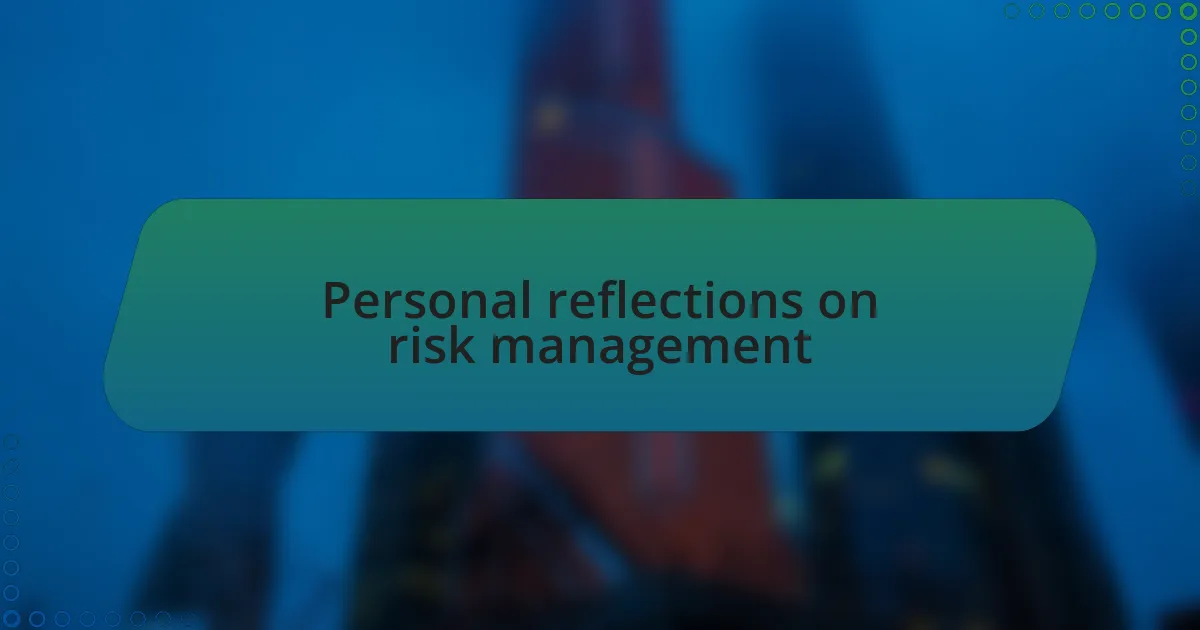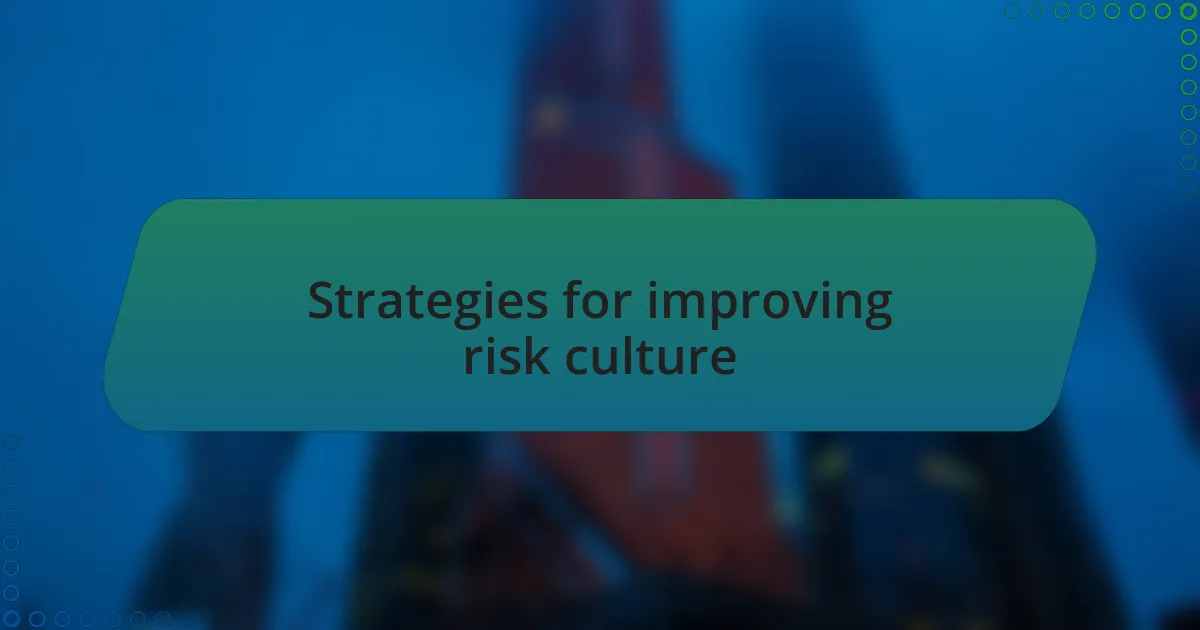Key takeaways:
- Risk culture is influenced by mindset, where informed understanding promotes growth compared to fear-driven conservatism.
- Leadership styles and organizational transparency play crucial roles in fostering open conversations about risk, empowering team members to share concerns.
- Regular training and integration of risk discussions into daily processes can enhance risk management culture and encourage collective ownership.
- Personal experiences, including embracing failures and modeling accountability, significantly shape an organization’s risk culture and promote shared responsibility.

Understanding risk culture in investing
Risk culture in investing is about how individuals and organizations perceive and manage risks. I remember my early days in investment consulting when I witnessed a client hesitating to diversify their portfolio. They feared potential losses rather than viewing investments as opportunities for balanced growth. This experience highlighted how our mindset shapes our approach to investments.
When considering risk culture, it’s crucial to ask ourselves: Are we driven by fear or informed understanding? In my experience, fear can lead to overly conservative choices, missing out on potential returns. Conversely, a well-informed risk culture encourages calculated risks, allowing investors to pursue growth while managing their comfort levels.
Another aspect is the influence of team dynamics in shaping our risk culture. I once collaborated with a team that thrived on diverse perspectives, where each member openly shared their views on risk. This openness led to richer discussions, resulting in a more robust investment strategy that balanced various risk appetites and ultimately yielded favorable outcomes.

Factors influencing risk culture
One primary factor influencing risk culture is leadership style within an organization. I once worked with a firm where the leadership promoted a culture of transparency and open dialogue. This approach not only encouraged team members to voice their concerns about risk but also fostered a sense of trust. I remember sitting in a meeting where a junior analyst felt safe sharing her apprehensions about a high-stakes investment. That moment reminded me that when leaders model vulnerability, it empowers the entire team to engage more actively in risk discussions.
Another critical element is the regulatory environment affecting investment practices. In one instance, I observed how changes in regulations prompted a client to reassess their risk tolerance. It was fascinating to see how external pressures could reshape an organization’s attitude toward risk. Have you ever experienced a shift in your own investment strategy due to new rules? It’s essential to recognize that these influences can either cultivate a cautious or a more adventurous risk culture, depending on how organizations adapt to such changes.
Additionally, past experiences play a significant role in shaping an individual’s or organization’s perception of risk. Reflecting on my own journey, early setbacks in investments taught me valuable lessons about resilience and risk assessment. Each failure pushed me to reevaluate my approach, ultimately transforming my relationship with risk. When considering your own experiences, think about how they might influence your current decision-making. The emotional scars of past decisions can either hold us back or propel us forward into more informed choices.

Assessing risk culture in organizations
Assessing risk culture involves evaluating how an organization’s values, beliefs, and practices align with its approach to risk management. I remember a project where we implemented a survey to gauge employees’ perceptions of risk. The results revealed unexpected insights—many felt uncertain about their roles in risk assessment, highlighting a need for clearer communication and training. Isn’t it fascinating how perceptions can sometimes diverge from reality?
Another effective way to assess risk culture is through focus groups and interviews. In one instance, I led a discussion with team members across several departments. Their candid reflections revealed not just gaps in risk knowledge but also a shared desire for a more proactive stance toward potential challenges. When was the last time you had a conversation like that in your organization? Engaging directly with employees can uncover valuable perspectives that formal assessments might miss.
Periodic reviews and stress tests can also be invaluable in understanding how well an organization’s risk culture is functioning. I recall an experience where a simulated crisis revealed the strengths and weaknesses in our risk response protocols. The exercise was eye-opening—sometimes, it takes a scenario to bring underlying issues to light. How prepared is your organization to handle unexpected risks? Taking these proactive steps can significantly enhance not only awareness but also preparedness within a firm.

Personal reflections on risk management
I often find that my approach to risk management has evolved through personal experiences. A few years ago, I faced a daunting investment decision with substantial stakes. Despite my careful research, I felt an uneasy knot in my stomach. This taught me that emotions can be just as relevant as data in risk assessment, highlighting the importance of acknowledging one’s feelings in decision-making.
In another instance, I was part of a team tasked with overhauling our risk policy. During brainstorming sessions, I was surprised to hear colleagues volunteer their fears openly. It struck me how vital it is to foster an environment where vulnerability is accepted. When were you last reminded that sharing concerns can lead to innovations in risk strategy? Creating a safe space allows organizations to tap into a wealth of insight that might otherwise remain hidden.
Reflecting on past challenges, I’ve realized that risk management isn’t solely about numbers and forecasts; it’s also about the stories we tell ourselves and each other. In one project, my team faced unanticipated market shifts. Instead of panicking, we shared our thoughts and reframed the narrative around adaptability. Isn’t it powerful to think that our mindset can significantly alter our response to risk? This personal shift led to more resilient strategies, showing me that a collective perspective can make all the difference.

Strategies for improving risk culture
One effective strategy for improving risk culture is to implement regular training sessions focused on identifying and managing risks. In one of my previous roles, we held workshops that encouraged our team to discuss past mistakes openly. What struck me was how sharing these experiences not only built trust among colleagues but also transformed our approach to risk; it became less about avoiding pitfalls and more about learning and growing from them together.
Another key approach is integrating risk discussions into everyday business processes. I remember when our team started including a ‘risk review’ segment in our weekly meetings. Initially, I was skeptical, wondering if it would be just another checkbox exercise. However, the conversations that sprung from this practice revealed hidden fears and sparked innovative solutions. Have you ever noticed how simply talking about risks can create a sense of ownership among team members? It certainly did for us.
Additionally, recognizing and rewarding proactive risk management can significantly enhance a culture centered around risk awareness. I once worked for an organization that celebrated team members who showcased exceptional risk identification skills. This not only motivated individuals to actively participate in risk discussions but also inspired a collective responsibility towards risk management. Isn’t it amazing how recognition can lead to significant cultural shifts? Emphasizing these small victories can foster an environment where everyone feels empowered to contribute to risk management.

Lessons learned from my experiences
In my journey through different organizations, I’ve learned that fostering open dialogue about risk is a game-changer. There was a moment in a meeting when a junior analyst shared her fear of speaking up about potential risks in our new project. It hit me then—her vulnerability created a ripple effect, encouraging others to express their concerns too. Isn’t it refreshing when a simple act of honesty transforms the atmosphere?
Reflecting on my own experiences, I’ve discovered that the best lessons often arise from failure. Once, we faced a significant setback due to overlooked risks in a market shift. Instead of shifting blame, we embraced it as a learning opportunity. That failure led to a comprehensive review process that we still use today, and it has steered us towards more informed and confident decision-making. Have you ever turned a setback into a stepping stone?
Perhaps one of the most profound lessons was realizing how personal responsibility shapes risk culture. When I took on a leadership role, I made it a point to model accountability, owning up to my decisions and their outcomes. This simple approach resonated with my team, encouraging them to take similar ownership. It reminded me that when leaders demonstrate transparency, they inspire others to follow suit. How powerful is that ripple effect in cultivating a culture of responsibility?